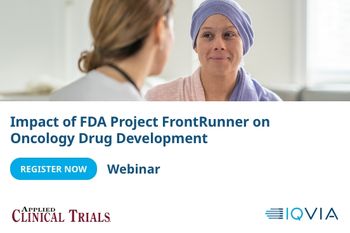
Applied Clinical Trials Supplements
- Supplements-10-02-2004
- Volume 0
- Issue 0
The Future of Clinical Diagnostics
Pharmaceutical industry trends will directly impact the clinical diagnostic world, resulting in a more integrated therapeutic strategy.
Pharmaceutical industry trends will directly impact the clinical diagnostic world, resulting in a more integrated therapeutic strategy.
The pharmaceutical industry's approach to developing and marketing new products will change significantly over the next 10 years, with parallel change expected in the clinical diagnostics industry. The global pharmaceutical market is estimated to reach $645 billion in 2004, but is showing signs of maturity. Analysts are predicting single-digit growth of approximately 8.7% year-over-year by 2008.1 In order to maintain growth expectations, many pharmaceutical companies are evaluating changes in their strategic direction in search of growth opportunities to sustain their blockbuster franchises.
The traditional blockbuster model is under attack by both niche market players?as in the areas of diabetes, breast cancer, and lipid disorders?and more broadly by generic competition. Companies are rethinking their "go to market" strategies with more energy focused on go/no-go decisions, long-term investment commitments, scientific advancements, and strategic positioning of their drugs as part of a more comprehensive approach to medical treatment.
Economic pressures are driving the need for change. Generics pose the largest financial threat to the pharmaceutical industry. In 1999, generics contributed only 3% to the total volume growth of the global pharmaceutical market. In 2003 their contribution to growth reached 28% and it continues to rise.2 Additionally, emerging world markets of India, China, and Southeast Asia have traditionally been the homes of generic suppliers, although they offer potential sales growth. By 2008, the global pharmaceutical market is estimated to be $901 billion, therefore the market share gained by generics is a major motivating force for pharmaceutical companies to delve into areas that further differentiate their drugs in the marketplace. Consequently, trends are emerging that have the potential to alter drug development and reshape marketing approaches. Among the many current trends impacting health care, four areas are expected to bring pharmaceutical and diagnostics closer together.
1. Advances in pharmacogenomics research. Pharmacogenomics utilizes knowledge of the patient genetic profile to influence decisions on treatment. It is considered by many to hold the key to the future of drug research, but some remain skeptical of its immediate impact. The use of pharmacogenomics will create medical, ethical, legal, and regulatory pressures that will cause diagnostic companies to develop rapid high-throughput assays to optimize patient diagnosis. The impact of these changes will inevitably require the pharmaceutical and diagnostics industries to collaborate to meet future demands.
2. Biomarker research: A biomarker is defined as a characteristic that is objectively measured or evaluated as an indicator of a normal biologic process, a pathogenic process, or a pharmacological response to a therapeutic intervention.3 The development pipeline shows an increasing number of compounds that rely on biomarker evaluations in their decision process. Drugs will be developed in concert with simple and reliable tests for molecular markers, which demonstrate continuing efficacy. Given these observations, the impact of newly discovered biomarkers on clinical diagnostics is likely to evolve toward an interdependent dynamic between new drugs and new diagnostics.
3. Comprehensive disease management programs. The potential impact that comprehensive programs will have on health care will involve monitoring of a patient's disease progression and pinpointing treatment choices through improved clinical assessments. Selected therapeutic areas and indications will take into consideration the patient's well-being, including quality of life, alleviation of suffering, drug treatment, and other services. Each area involves diagnostic testing to varying degrees.
4. Changing market dynamics. Patients in a number of disease areas are surviving significantly longer, requiring long-term management. Prescription drug benefits and the possibility of new medicines to treat prolonged diseases will drive market expansion. Furthermore, the demand for drugs and diagnostics will increase as the population ages. These forces will drive above average growth in selected therapeutic areas.
Advances in pharmacogenomics
Pharmacogenomics is the study of the variability in drug handling or response due to hereditary factors in different populations. The subjects' genotype may impact pharmacodynamics (drug concentration versus time versus pharmacological effect), pharmacokinetics (absorption, distribution, metabolism, and excretion) and/or the incidence of adverse events. The use of pharmacogenetic tests to determine this genetic variation can facilitate correct drug selection for treatment efficacy and minimize adverse events. A pharmacogenetic test is basically an assay intended to study individual variations in whole-genome or candidate gene single-nucleotide polymorphism (SNP) maps, halotype markers, and alterations in gene expression or inactivation that may be correlated with pharmacological function and therapeutic response. The FDA drafted guidelines for pharmaceutical companies regarding pharmacogenomics research and submission of this data for review by the "Interdisciplinary Pharmacogenomic Review Group" in November 2003. The intent of this document was to clarify FDA policy in this area for the pharmaceutical industry. This document provided insights into potential areas of interest at the FDA concerning pharmacogenomics research. However, it did not provide explicit direction to the extent to which this data will be required as part of the drug approval process in the future. Therefore, there is no prevailing consensus among pharmaceutical companies regarding future FDA expectations and the extent that this type of information will be required for drug approval.
One of the first examples of genetic variations is in genes encoding cytochrome P450 enzymes. The CYP2D6 gene, which is well characterized for controlling key pathways of drug metabolism, is expected to be important to clinical medicine.4 Mutations of the CYP2D6 gene are responsible for varying degrees of metabolism; the most clinically significant are ultra- rapid and poor metabolizer phenotypes. Two examples during drug treatment include a slowing in progression of coronary atherosclerosis in B1/B1 homozygotes receiving pravastatin compared with B2/B2 homozygotes,5 and caucasian males with HLA b57 variant were at increased risk for experiencing hypersensitivity to abacavir.6 Genotyping of this kind has shown value in a few specific cases. Many researchers suggest that it will play a more vital role in mainstream clinical practice in the next decade, with cardiovascular and central nervous system drug metabolism seen as the most likely areas for exploration.
The key to the most significant advances that might affect clinical diagnosis will be the pharmacodynamic effects of drug therapy, and the potential reduction of adverse events. Challenges to routine adoption of this approach include cost of genotyping to the patient and technical feasibility. Nevertheless, the potential for an influx of drug-diagnostic combinations in the pipeline is significant. For example, researchers in the area of psychiatry have largely exhausted traditional pathways for discovery, and will likely pursue broad searches of the human genome for new development targets. It is hoped that advances in technology will facilitate the search for new targets across the genome, resulting in clinical studies aimed at identifying pharmacodynamic markers of drug response. These specific areas of medicine are where pharmacogenomics should have a profound impact on mainstream clinical practice versus traditional drug discovery techniques.
Other experts are focused on the socioeconomic impact regarding the availability and use of genetic information. The Nuffield Council on Bioethics sought consultation from experts to provide advice on specific issues within three general areas: 1) issues related to the development and regulation of medicines, 2) the provision of tests and medicines, and 3) the use and storage of genetic information. Below are examples of how the handling of this information might impact pharmaceutical and diagnostic companies.
- If an argument can be made for genotyping subjects prior to enrollment in a clinical trial to reduce screening failures, the FDA may expect sponsors of clinical trials to incorporate pharmacogenetics testing in protocols.
- The application of subject-specific genetic information goes beyond whether a subject is a "responder" or "nonresponder." In fact, the available data could predict the degree to which a subject will actually respond. Diagnostic tests may therefore play an integral role in selecting an ideal drug therapy or combination therapy, and help predict the therapeutic outcome.
- The use and storage of genetic information will be controlled more closely through government regulation. Diagnostic companies will have to validate processes associated with managing this information to protect patient confidentiality.
For diagnostic testing to be fully accepted in this area, it must provide an economical, rapid, and accurate solution. Advances in molecular technology must lead to the development of equipment which has a high samples throughput. Additionally, it is preferable to analyze multiple SNPs in one sample, and this will be possible with the advancement of multiplex and chip technology. However, regulatory authorities will require thorough validation of these tools, to demonstrate both standardized manufacture and clinical efficacy.
Biomarker research
There is a high level of interest among pharmaceutical and diagnostic companies in biomarker research. One of the most important areas where biomarkers can impact the drug development process is attrition rate of compounds in clinical trials. The pharmaceutical industry typically develops 10 drugs through various stages of clinical development for every one that enters the marketplace. For years, researchers have worked toward improving those odds. The use of biomarkers in early phase clinical trials potentially improves the odds by providing definitive information regarding safety and efficacy leading to informed go/no-go decisions. Biomarkers help reveal disease targets, show biochemical pathways, and confirm mechanisms of drug action. For example, oncology researchers incorporate biomarkers such as CA 125 (ovarian cancer), CA 15-3, and 27-29 (breast cancer), CEA (ovarian, lung, breast, pancreas, and gastrointestinal tract cancers), and PSA (prostate cancer) in many clinical trial protocols. Therefore, drugs with the highest probability of success are developed further while other compounds are discontinued.
Increasingly, FDA is encouraging pharmaceutical companies to utilize biomarkers as surrogate endpoints to predict clinical benefit/harm based on epidemiologic, therapeutic, pathophysiologic, or other scientific evidence. Much attention is now focused on biomarkers present at the cellular level, such as cytokines.
As new drug candidates advance through the phases of clinical development, newly discovered esoteric biomarkers demonstrate their value as sensitive indicators of both efficacy and, occasionally, safety. However, in late-phase development only the most valuable biomarkers become surrogate endpoints in clinical trials. The challenge faced by drug developers is to identify "high value" biomarkers for specific disease indications and incorporate them into early phase protocols. Diagnostic companies are partnering with pharmaceutical companies to develop and validate comprehensive menus of esoteric and nonesoteric biomarker assays to support their drug development programs.
Again, as with pharmacogenetic testing, the diagnostic challenge for biomarkers is an economical, accurate, and rapid testing solution. The advent of proteomics will no doubt provide an increasing spectrum of biomarker candidates. The move to multiplexing will allow multiple biomarkers to be analyzed in one sample. When this develops into a fully automated technology, multiple markers will be screened in thousands of patients.
For example, one leading pharmaceutical company is currently researching a biomarker that has the potential to characterize the action of their drug in the treatment of atherosclerosis. Individuals who are at risk for coronary artery disease may benefit from a newly discovered breakthrough involving the enzyme Lp-PLA2. Lp-PLA2 usually binds to LDL cholesterol in the blood and has been found to be present in atherosclerotic plaque. Lp-PLA2 is believed to sequester inflammatory mediators leading to coronary heart disease. A drug is being developed that will block this mechanism, resulting in improvement of the patient's condition.5
Major markets where biomarkers are being widely used and developed include oncology, hematology, HIV/AIDS, diabetes, and heart disease. Pharmaceutical and diagnostics companies are investing hundreds of millions of dollars in biomarker research, with the hopes of developing drugs that effectively treat many challenging diseases.
Comprehensive disease treatment programs
In recent years, researchers have been keenly aware of the increasing demand for new medicines, vaccines, and biologics to meet the needs of patients. They have focused on both pediatric indications and diseases of the elderly. Diseases involving metabolic syndrome, osteoporosis, osteoarthritis, rheumatoid arthritis, and multiple myeloma are just a few that require comprehensive treatment, including ongoing diagnostic assessments and drug therapy to manage patients' well being.
Metabolic syndrome. Metabolic syndrome plays a critical role in a large number of illnesses ranging from pediatric disorders to diseases of the elderly. In fact, it represents one of the most serious health care concerns to western and affluent society. In 2002, The Centers for Disease Control and Prevention reported that one in five adults in the United States has metabolic syndrome. Complications from this condition lead to hardening of the arteries and an increased risk for cardiovascular and kidney disease. A combination of interrelated metabolic risk factors that occur in one person defines metabolic syndrome, e.g., physical inactivity, obesity, atherogenic dyslipidemia (unhealthy lipid levels), elevated blood pressure, abnormal blood sugar, prothrombotic state (high fibrinogen or plasminogen activator inhibitor [-1] in the blood), and proinflammatory state (elevated high-sensitivity C-reactive protein in the blood). Therefore, metabolic syndrome frequently results in type-2 diabetes, coronary heart disease, stroke, and other diseases related to plaque build-ups in artery walls. Furthermore, researchers are investigating genetic factors that contribute to the development of metabolic syndrome. A comprehensive approach to the treatment of many of these diseases offer the best chance for enhancing quality of life. Long-term patient monitoring, drug therapy, and dietary control can prolong the onset of complications such as kidney failure, heart attack, paralysis, and coma. Although recent discoveries show progress in diseases related to metabolic syndrome, pharmaceutical and diagnostic companies will continue to invest in improving diagnostic tests and drug treatment options for many diseases related to metabolic syndrome.
Osteoporosis. Osteoporosis has been an underdiagnosed disease affecting elderly women, but diagnosis and treatment have improved significantly during the past decade. Technology for bone mineral density measurements have improved diagnoses, while new drugs (alendronate, risedronate, raloxifene, calcitonin, cyclical etidronate, and hormone replacement therapy) have augmented or replaced traditional calcium and vitamin D supplementation therapy. Unfortunately, calcium therapy declined from 43% in 1994 to 24% in 2003, although clinicians agree that it remains a necessary part of therapy for this disease.6 Furthermore, in 2002, the Women's Health Initiative (WHI) published a study that showed long-term use of hormone replacement therapy increases the risk of cancer and cardiovascular disease. These developments underscore the need for a comprehensive approach to the treatment of osteoporosis that takes into account diagnostic assessments, drug therapy, quality of life, and potential long-term risks.
Multiple myeloma. Multiple myeloma is an incurable bone marrow cancer that has a devastating effect on the elderly; however, recent clinical trials have shown that combination drug therapy is showing positive results and increasing survival. The use of thalidomide and the steroid dexamethasone reduces antibody-like proteins that are an indicator of the disease. Diagnostic tests used to detect an elevation in these proteins include routine blood tests and the monochromal or myeloma protein test. Thalidomide is used "off label" for multiple myeloma while a new drug that works through an entirely different mechanism, Velcade, is available. Both drug therapies have improved patient outcomes, while stem cell research shows promise as a potential cure. An ongoing National Institutes of Health trial is evaluating the use of "tandem" stem cell transplants to destroy the cancer. Another innovative approach being studied uses high doses of drugs first, followed by one stem cell transplant from a donor where the donor's immune system is the source of the immune therapy.
Changing market dynamicsLong-term demographic projections show a steady increase in the percentage of the population over the age of 60 during the next 10 years, continuing far into the future.7 It is expected that many of these people will require the support of health care programs. While most authorities agree that scientific innovation will offer new therapies in the future, the question persists regarding "who pays" and to what extent. Recently, the U.S. Government added prescription drug coverage to the Medicare program. This was a major step for senior citizens, that allocates $400 billion worth of public funds for prescription drugs. The law is expected to positively impact the drug industry, primarily due to increased access to medicines resulting in drug spending growth of more than $125 billion by 2006.8
Shifting population demographics will require an increase in funding to support new medicines that treat prolonged disease therapies covered by Medicare. Both pharmaceutical and diagnostic companies are working toward better understanding how they will be impacted by reimbursement decisions in the future. Drug reimbursements currently available through Medicare will be an indicator of the areas where diagnostic testing may expand. These market forces will ultimately enable pharmaceutical and diagnostics companies to select disease indications that deliver the greatest return on investment to remain competitive in key markets.
Summary
Health care companies will sharpen their focus on disease indications in order to maintain competitiveness within their markets. Although the global pharmaceutical market has shown signs of slower growth rates, medical and technical innovation in a number of therapeutic areas have triggered new market expansion. A fully integrated model for developing disease therapies will blur the lines between drug discovery, diagnostics, and treatment. Several disease indications are already seeing the first application of these converging trends. Additionally, patients' life expectancy is being prolonged and a greater success rate is possible in the early stages of clinical drug development. These new approaches to drug discovery and treatment will steer the pharmaceutical and diagnostic industries closer together. Consequently, the large growth potential driven by these trends will work against the traditional big-market, "one size fits all" blockbuster model currently used by the health care industry.
References1. RB-191 World Pharmaceutical Markets (Business Communications Company, Inc., 25 Van Zant Street, Norwalk, CT 06855, March 2004).
2. The Global Pharmaceutical Market?current and future trends (IMS Health: MIDAS, MAT, Dorfplatz 4 T6330 Cham, Switzerland, December 2003).
3. Biomarkers Definitions Working Group, "Biomarkers and surrogate endpoints: Preferred definitions and conceptual framework," Clinical Pharmacology & Therapeutics, 69 (3) 89?95 (2001).
4. H.L. McLeod, E.Y. Krynetski, M.V. Relling, W.E. Evans, "Genetic Polymorphism of Thiopurine Methyltransferase and its clinical relevance for childhood acute lymphoblastic leukemia," Leukemia, 14 (4) 567?72 (2000).
5. J.A. Kuivenhoven, J.W. Jukema, A.H. Zwinderman, P. de Knijff, R. McPherson, A.V.G. Bruschke, K.I. Lie, J.J.P. Kastelein, "The Role of a Common Variant of Cholesteryl Ester Transfer Protein Gene in the Progression of Coronary Atherosclerosis," New Eng J Med, 338, 86?93 (1998).
6. S. Hetherington, A.R. Hughes, M. Mosteller, D. Shortino, K.L. Baker, W. Spreen, E. Lai, K. Davies, A. Handley, D.J. Dow, M.E. Fling, M. Stocum, C. Bowman, L.M. Thurmond, A.D. Roses, "Genetic Variations in HLA-B Region and Hypersensitivity Reactions to Abacavir," Lancet, 359, 1121 (2002).
7. "The Ageing of the World's Population: Long-Range World Population Projections: Based on the 1998 Revision" (The Population Division, Department of Economic and Social Affairs, United Nations Secretariat).
8. C. Boersig, "After Medicare," MedAd News, 23 (1) (2004).
Anthony J. Santicerma,*MS, is director of marketing with Quest Diagnostics Clinical Trials, 1201 South Collegeville Road, Collegeville, PA 19426, (610) 454-6542, fax (610) 983-2045, email: anthony.j.santicerma@questdiagnostics.com.Mark M. Engelhartis vice president of sales and marketing with Quest Diagnostics Clinical Trials, (610) 454-4767, fax (610) 983-2045, email: mark.m.engelhart@questdiagnostics.com.Michael H. Harvey,PhD, is director of medical and regulatory affairs with Quest Diagnostics Clinical Trials, (011) 44-208-377-3358, fax (011) 44-208-377-3350, email: mike.h.harvey@questdiagnostics.com.
*To whom all correspondence should be addressed.
Articles in this issue
about 21 years ago
The Thorough Phase I ECGNewsletter
Stay current in clinical research with Applied Clinical Trials, providing expert insights, regulatory updates, and practical strategies for successful clinical trial design and execution.




